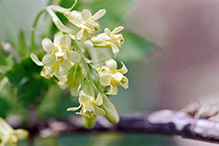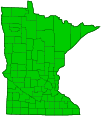American black currant
(Ribes americanum)
Conservation • Wetland • Description • Habitat • Ecology • Use • Distribution • Taxonomy
Description |
American black currant is an 40″ to 60″ tall, erect, perennial shrub that sometimes forms thickets. The stems are erect or ascending, slender, and ridged. They do not have spines or bristles. Young stems are finely hairy with yellow glands. Older stems are gray and hairless. The buds are brown, hairy, egg-shaped, ⅛″ to 3 ⁄16″ long, with a blunt tip. The leaves are alternate, stalked, 1″ to 2⅜″ long, and 1⅛″ to 3⅛″ wide. They are broadly egg-shaped in outline with a flat or shallowly heart-shaped base. They are palmately lobed, with 3 or 5 pointed lobes, and palmately veined. The upper surface is dark green, hairless, with scattered yellow glands. The lower surface is paler green, hairy along the veins, with many yellow glands. The margins are deeply toothed or double-toothed. The inflorescences are in elongated, unbranched, clusters (racemes) of 8 to 20 or more flowers. The racemes are 2″ to 3⅛″ long and drooping, with a hairy central axis. There are 2 conspicuous bracts at the base of the raceme. The bracts are lance-shaped, hairy, and much longer than the flower stalks. The flowers are yellowish-white, about ⅜″ long, and bell-shaped. There are 5 petal-like sepals fused together at the base into a short tube, with 5 lobes that spread widely and bend backward at the tip. They are sparsely hairy on the outside and have no yellow glands. There are 5 blunt-tipped petals that are shorter than the sepals and are pressed together forming a tube. There are usually 5, sometimes 4 stamens, that are shorter than the petals and do not protrude from the tube. The ovary is hairless and has no bristles, prickles, or yellow glands. The style is as long as or slightly longer than the stamens. The fruit is a black, juicy berry. It is almost round, 5 ⁄16″ to ⅜″ in diameter, hairless, and has no bristles or prickles. |
Height |
40″ to 60″ |
Flower Color |
Yellowish white |
Similar Species |
European black currant (Ribes nigrum) has flowers on stalks that are much longer than the minute, subtending bracts. The sepals are densely hairy on the outside. The sepals and ovary have scattered, yellow glands. Northern black currant (Ribes hudsonianum) racemes are erect or ascending. The flowers are on stalks that are much longer than the minute, subtending bracts. The sepals are densely hairy on the outside. |
Habitat |
Moist. Upland woods, floodplains. |
Ecology |
Flowering |
Late April to early June |
Pests and Diseases |
|
Use |
|
Distribution |
||
|
Sources |
|
| 5/3/2024 | ||
Nativity |
||
Native |
||
Occurrence |
||
Common |
||
Taxonomy |
|
Kingdom |
|
Division |
Tracheophyta (Vascular Plants) |
Subdivision |
Spermatophytina (Seed Plants) |
Class |
|
Superorder |
Saxifraganae |
Order |
Saxifragales (saxifrages, stonecrops, and allies) |
Family |
Grossulariaceae (gooseberry) |
Genus |
Ribes (currants and gooseberries) |
Subgenus |
Ribes |
Section |
Botrycarpum |
Subordinate Taxa |
|
|
|
Synonyms |
|
Coreosma americana Coreosma florida Ribes campanulatum Ribes floridum Ribes floridum var. grandiflorum Ribes intermedium Ribes nigrum var. pennsylvanicum Ribes recurvatum |
|
Common Names |
|
American black currant black currant gooseberry currant wild black currant |
|
Glossary
Bract
Modified leaf at the base of a flower stalk, flower cluster, or inflorescence.
Palmate
Similar to a hand. Having more than three lobes or leaflets that radiate from a single point at the base of the leaf.
Raceme
An unbranched, elongated inflorescence with stalked flowers. The flowers mature from the bottom up.
Sepal
An outer floral leaf, usually green but sometimes colored, at the base of a flower.
Visitor Photos |
||
Share your photo of this plant. |
||
This button not working for you? |
||
Greg Watson |
||
 |
|
|
MinnesotaSeasons.com Photos |
||
 |
 |
|
Plant |
Plant |
|
 |
 |
|
Inflorescence |
Inflorescence |
|
 |
 |
|
Inflorescence |
||
|
||
|
||
|
Flowers |
|
 |
 |
|
Flowers |
Flowers |
|
 |
||
Stem |
|
|
 |
 |
|
Leaves |
Leaves |

Visitor Videos |
||
Share your video of this plant. |
||
This button not working for you? |
||
|
Other Videos |
||
Frank Cook on Black Currant - Ribes nigrum |
About
Uploaded on Jan 30, 2009 http://www.EatWeeds.co.uk - Herbalist Frank Cook, the internationally renowned edible wild plant expert, explores the importance of Black Currant (Ribes nigrum) as food and medicine. |
BlackCurrant |
About
Uploaded on Aug 2, 2011 The Black Currant is another in my series on he nutraceutical plants that can be used as both for food and medicine. Black currants are a perennial species of the Ribes berry native which is native to central and northern Europe and northern Asia. The fruit has extraordinarily high vitamin C content (302% of the Daily Value per 100 g, table), good levels of potassium, phosphorus, iron and vitamin B5, and a broad range of other essential nutrients. The big deal is that phytochemicals (polyphenols/anthocyanins) are contained in the the fruit and have been demonstrated in laboratory experiments to have the potential to inhibit inflammation mechanisms suspected to be at the origin of heart disease, cancer, microbial infections or neurological disorders like Alzheimer's disease. Yes you heard that right to inhibit neurological disorders like Alzheimer's disease. Blackcurrant seed oil is also rich in many other nutrients, especially vitamin E and several unsaturated fatty acids including alpha-linolenic acid and gamma-linolenic acid. Culinary uses mostly include the making of jams, jellies or preserves but also in beverages. In fact in the UK they make a blackcurrant cordial mixed with cider to make a drink called "Cider and Black". The addition of lager results in "Diesel" or "Snakebite and Black" available at pubs. Adding a small amount of blackcurrant juice to Guinness is preferred by some to heighten the taste of the popular stout. Blackcurrants were once popular in the United States but were banned in the early 1900s. That was a time when blackcurrants, as a vector of white pine blister rust, were considered a threat to the U.S. logging industry. Things have changed and they are making a comeback. |

Visitor Sightings |
||
Report a sighting of this plant. |
||
This button not working for you? |
||
Greg Watson |
Location: Wagon Wheel Trail, La Crescent, MN. Solitary Sandpiper in flight |
 |
MinnesotaSeasons.com Sightings |
||
Avon Hills Forest SNA, North Unit Charles A. Lindbergh State Park Clifton E. French Regional Park John Peter Hoffman Spring Brook Valley WMA Lake Alexander Woods SNA, South Unit Minnesota Valley NWR, Black Dog Unit Minnesota Valley NWR, Chaska Unit Mound Spring Prairie SNA, North Unit Nerstrand Big Woods State Park |

|
Created: 5/7/2009 Last Updated: © MinnesotaSeasons.com. All rights reserved. |


